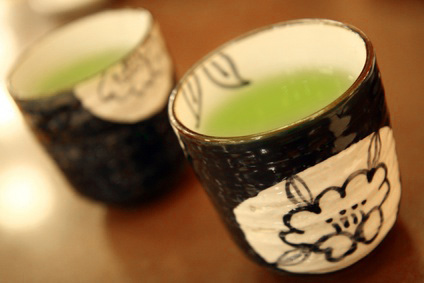
 |
Gyokuro (玉露) is a fine and
expensive type of green tea from Japan. Selected
from a grade of green tea known as sencha (煎茶),
gyokuro's name refers to the pale green color of
the infusion. Most of sencha is made by Yabukita
variety, but Gyokuro is often made by
specialized variety such as Asahi, Okumidori,
Yamakai and Saemidori.
Merchants selling Japanese green tea will
typically recommend a unique method for brewing
gyokuro:twice the weight in dry tea leaves for a
given quantity of water (e.g. 6 to 10 grams for
180 ml);cooler brewing temperatures (in the
range of 50ºC-60ºC instead of 65ºC-75ºC for
sencha, High-end Gyokuro such as National tea
jury rank-in is at 40ºC);a longer steeping
duration, at least for the first infusion (90
second instead of 1 minute for sencha).
Since gyokuro steeps at such a mild temperature,
sources may recommend pre-heating both the pot
and cup to maintain the warmth of the tea as one
drinks it. One usually drinks gyokuro very
slowly to savor its distinctive flavor. |
 |
Though it is
categorized as a type of sencha according to
production methods, gyokuro cultivation differs
from other sencha teas. Gyokuro tea leaves are
covered up to be shielded from the sun for at
least two weeks before being harvested. This
causes the amino acids (Theanine) and caffeine
in the tea leaves to increase, while catechin
(the source of bitterness in tea) decreases,
giving rise to a sweet flavor. The tea also
gains a distinct aroma from the covering
process. This type of cultivation is also used
in producting tencha, (碾茶) but records indicate
that this process had already been developed in
the Azuchi-Momoyama period.
Gyokuro is one of the most expensive types of
sencha available in Japan. The name comes from
the product name given to the tea by the
Yamamotoyama company. The tea was first
discovered by Yamamotoyama's sixth owner,
Yamamoto Kahei, in 1835 (Tenpō year 6). The
process was completed by another manufacturer at
the start of the Meiji period.
 |
|
|
 |
|





